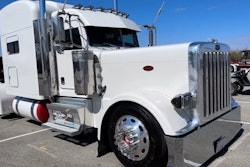Advances in electronics are reducing the need for a cockpit full of needles. Make sure the gauges you choose give you the data you need.
The trucking industry is polarized when it comes to gauges, says Kenworth’s Gary Ziebell, a project engineer. “Sometimes it seems as if owner-operators don’t care what information the package imparts, as long as it looks retro,” he says. “Unless it can be packaged as an analog gauge with a needle, they don’t want it. On the other hand, the fleet guys want no gauges at all.”
“And this means fleets don’t have enough information on the dash for the good driver,” interjects Kenworth’s assistant chief engineer Dan Farmer. “The problem,” Ziebell says, “is that neither party sees the value of gauges.”
For the owner-operator who wants to operate as efficiently as possible, there is plenty of value in knowing what’s going on with everything from the radiator to the rear axles. While only so many gauges can be crammed onto any given dash, certain digital gauges offer improvements over analog versions, and new developments in electronics make it possible to run multiple sources of data through one display unit. A smart choice of gauges, whether in spec’ing a new truck or installing aftermarket products, can help you head off problems before they happen.

Aftermarket gauges can often replace original equipment gauges in their positions or fit into unused circles in the dash. A replacement must be of the right diameter – often 2/-inches – and might require a mounting bracket.
Peterbilt’s owner-operator customers have a keen interest in taking the pulse of all their truck systems, says Todd Acker, Peterbilt’s over-the-road brand manager. “These truckers are accustomed to scanning every gauge, and many could close their eyes and tell you the location of every one on their dash. They also are likely to want a dashboard that reflects their individuality.”
Mack customers prefer analog gauges, says Mack Powertrain Division’s Wayne Wissinger. However, he believes “all drivers will approve of Mack’s coming digital display, located on the B-panel to the right of the driver. It will be high resolution and easier to read, and you can put lots of information there.” A display consisting of a drivetrain diagram with the fluid temperature for each component shown next to it replaces an array of gauges that would take up much more room. The system automatically warns the driver if something goes wrong.
With Freightliner’s digital system, “The engine messages are all on a common data bus, and we display them separately on the dash,” says Paul Menig, chief electrical engineer. The engine messages include the inputs for the speedometer, voltmeter, and oil pressure and coolant temperature gauges.
For International, “With electronic engines, the speedometer, tachometer, coolant temperature, and oil pressure information are transmitted over the ATA data link from the engine’s electronic control module to the speedometer/ tachometer module,” says Ron Welch, a marketing manager. International’s gauges feature warning lights and audible beeps to alert drivers of trouble.
On Volvos, the entire instrument cluster is multiplexed, which means many signals are sent on a common wire in encoded form, says engineer Jon Quigley. Each gauge then reads only the signal meant for it. The Volvo cluster connects with just three plugs and operates entirely via solid-state electronics, which “eliminates all problems with air sources or binding mechanical parts,” Quigley says.
Not only are gauges themselves changing, but because many engine and drivetrain functions are better controlled, some gauges have become less important. Critical ones are often managed by the engine’s electronic control module.
Take the oil pressure gauge. “To reduce parasitic losses, oil pressure’s regulated by a spring in the filter head discharge that dumps excess pressure,” says Kenworth’s Ziebell. “It doesn’t tell you when you’ve got the wrong viscosity oil or when the oil temperature is way up, either. So the reading has less value than in the past.” Besides, he adds, if oil pressure gets critically low, the ECM will give you a warning light and ultimately shut the engine down.
Ziebell and others also mention the high-capacity oil coolers on modern engines. The engine’s oil temperature normally “tracks the coolant temperature” once the engine is warmed up – unless the oil level is very low and you are working the engine extremely hard, Ziebell says. Critically high engine oil temperatures will cause the ECM to shut down or at least derate the engine.
A similar situation exists with the exhaust temperature pyrometer, says Ziebell. “On the latest engines, the pyrometer goes along for the ride because the ECM controls the exhaust temperature.”
Earl Evans, an owner-operator from Youngstown, Ohio, who drives a late-model Kenworth W900L, admits the pyrometer was more critical with older engines “because it would pick up overfueling,” something that is now much less likely to happen. But Evans, a methodical gauge watcher, checks his digital pyrometer frequently because, he believes, “It still gives you a good idea of what the engine is doing.”
Electronic and mechanical advances are challenging the traditional owner-operator cockpit full of analog gauges. It’s no longer far-fetched to imagine the day when you’ll be driving a truck with no gauges other than one or two interactive, electronic displays.
GAUGE BY GAUGE
Are gauges worth their cost? Bob Johnson, president of TelTek USA, a maker of digital aftermarket gauges, says the company’s outside temperature gauge costs $80 to $85, an oil pressure gauge goes for $130, and an air pressure gauge for $155. Other similar gauges cost between $50 and $160.
Whatever the expense, base your decision to buy on how much it will help you avoid downtime or otherwise save time or money.
Here are some optional and standard gauges and their particular advantages:
TACHOMETER. Novice drivers or those getting used to a different truck often use a tach to help them shift. Even if you’re experienced, you can gain some efficiency by studying the engine’s torque and power curves so you know where you really need to shift to increase power, and how low you can lug safely. Volvo’s tach is electronically linked to company-made and vendor engines so the green LEDs show the right fuel economy sweet spot for the engine and rating. It’s also helpful for heeding the rpm limit when using the engine brake.
COOLANT TEMPERATURE. This gives a warning of an overworked engine, corroded cooling system, low coolant, or water pump or drive failure.
ENGINE OIL TEMPERATURE. An excessive reading would most likely point to a failed (dirty) oil cooler, seriously sludged-up oil pan, or a leak and low oil level if the engine is working hard. It’s possibly more useful on EGR engines, though so far it looks like engine lube systems are handling the extra heat of EGR.
MANIFOLD BOOST PRESSURE. This is perhaps more useful than the pyrometer because overfueling that used to show up there now often shows up as lower boost pressure. However, readings will be irregular on EGR engines.
FUEL. Newer displays that tell you how far you can go before refueling can be quite helpful. That’s especially true if you have a truck with hired drivers because they sometimes run out of fuel. Digital displays that report fuel economy and idling time pay off if you bother to use the information.
EXHAUST PYROMETER. This measure of engine exhaust temperature will quickly detect overwork or overfueling, which is destructive to engines. But, with the ECM managing fuel and air on the latest engines, it might be a gauge to skip.
AIR INTAKE RESTRICTION. This is the best guide to timely air cleaner replacement intervals in high-mileage applications and is valuable when unanticipated clogging occurs.
FUEL RESTRICTION. Owner-operator Earl Evans swears by his restriction gauge because it makes it practical for him to use a finer, 2-micron filter, even though clogging varies greatly with the fuel quality. At $10 a pop, it saves money to replace the filter only after the restriction hits the red.
TRANSMISSION OIL TEMPERATURE. Transmissions work hard when in the lower gears and on the highway when running in overdrive. While synthetic lubes resist high temperatures, bearings and seals can be harmed by anything more than 250 degrees. Keeping an eye on this gauge will reveal either operating extremes or a cooler maintenance problem that could quickly lead you to the repair shop. If you’re a maintenance pro and run late-model equipment, this might be a place to save money.
AXLE TEMPERATURES. Drive axles don’t have coolers, and their EP (extreme pressure) lubes break down rapidly when over 250 degrees. A rise in axle lube temperature often indicates low fluid level, though careful pre-trips should reveal leakage before it’s critical. One big use is that differential overwork due to one low tire or forgetting to disengage the inter-axle differential will show up here. Evans likes this gauge because it not only clues you in about a surprise leak but “can warn you if there’s a bearing problem.”
OUTSIDE TEMPERATURE. This is frequently offered by truck makers because the information comes off the ECM. Johnson, of TelTek USA, says it’s by far his company’s best seller. Among other things, it indicates potential icing conditions. Evans swears by his because it also helps him evaluate lube oil temperatures and even subtle weather-related changes in air suspension pressure.
VOLTMETER. This is a basic gauge not always used to its full potential. A careful eye on the voltage can help you anticipate problems resulting from overworked batteries (drained during rest stops) that aren’t recharging or a borderline alternator or drive system.
BRAKE APPLY PRESSURE. This reports the air brake pressure supplied to the system by the treadle valve. Using this gauge to make sure you snub the brakes hard enough on a long, gradual descent could save a trip into a runaway truck ramp.
AIR SUSPENSION PRESSURE. Smart truckers know they can use air suspension pressure readings to estimate weight once they’ve tracked known tandem axle weights and comparable pressure readings. This can save money from overweight tickets.
ENGAGING THE MACK DASH
A Mack Truck survey about gauges shows drivers want these things:










